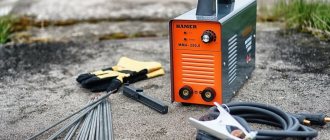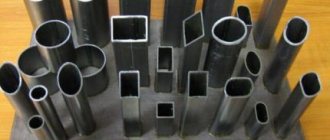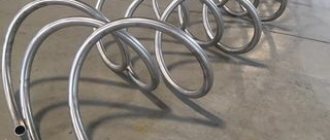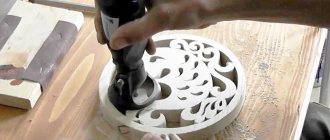MesterulManole
20892 0 3
MesterulManole July 25, 2016Specialization: many years of experience in finishing works of residential and office premises, dachas, country cottages, etc. Hobby: cycling in all its forms
Preheating of the deformable area
Hello dear readers. Today I’ll tell you how to bend a pipe without a pipe bender and with a pipe bender, and how to bend a polypropylene pipe. The topic is of considerable interest since without bent pipes it is difficult to build a greenhouse, gazebo or canopy over the porch.
Selecting a bend method
How to bend a pipe with your own hands? The question is not an easy one. When bending this product yourself, first of all, it is important to take into account the fact that during this process radial and tangential forces arise in the profiled metal, the impact of which can lead to rupture of the section and the appearance of folds on it.
To prevent this from happening, when forming a bend, it is necessary to take into account all the parameters of this process.
The technology that can be applied in each specific case is selected based on:
- Pipe material;
- Its size;
- Required bend angle and radius.
Having made a preliminary assessment of these parameters, you should choose one of the options proposed below. The photos below will help you understand the correct implementation of each of them, demonstrating step by step how to bend a pipe.
Determination of the conductor cross-section at the input
You can check the nominal values in the Energosbyt company or in the documentation for the product.
For example, the rating of the machine at the input is 25 A, the power consumption is 5 kW, the network is single-phase, 220 V. The cross-section is selected so that the permissible current of the cores over a long period is greater than the rating of the machine. For example, a three-core copper conductor VVGng, laid in an open manner, was installed in a house. The optimal cross-section is 4 mm2, so you will need VVGng 3x4 material.
After this, the indicator of the conditional shutdown current for a machine with a nominal value of 25 A is calculated: 1.45x25 = 36.25 A. For a cable with a cross-sectional area of 4 mm2, the parameters of the continuous permissible current are 35 A, conditional - 36.25 A. In this case, it is better to take the input copper conductor with a cross-section of 6 mm2 and a permissible maximum current of 42 A.
Heat
When exposed to high temperatures, many metals and their alloys become more ductile and less deformable. This rule applies to aluminum, duralumin, steel, copper, brass products and aluminum-ferrous bronze workpieces.
- When heating pipes made of tin bronze, gray cast iron or zinc alloys, you can get the exact opposite effect - they become more brittle when heated.
- It follows from this that not just any pipe can be heated for bending.
- It is possible to heat galvanized pipes, since their coating is not damaged in this case.
- When heating the product, you should not get too carried away, because under the influence of too high temperatures, oxygen begins to penetrate into the material, which entails its oxidation - an irreversible process that destroys the pipe. As an example, we can consider bending an aluminum billet.
- We heat the bending surface and bring a sheet of paper to it. If it lights up, the product can be bent.
As an indicator of the degree of heating of structures made of steel, their reddening to the state of scale can be used.
Pipe bending radius for devices used in everyday life and industry
On the construction market you can find a large number of devices for individual use for bending pipes, from simple springs to complex electromechanical machines with hydraulic feed.
Manual pipe benders
Pipe benders of this class are low cost, have a simple design, low weight and dimensions; the process of bending the workpiece occurs due to the physical effort of the worker. Based on the principle of operation, manual units produced by industry can be divided into the following categories.
Lever. Bending is achieved through a large lever, which reduces the applied muscle force. In such devices, a workpiece is inserted into a mandrel of a given shape and size (punch) and, using a lever, the product bends around a template surface - the result is an element of a given profile. Lever devices allow a 180-degree radius of curvature and are suitable for small diameter soft metal pipes (up to 1 inch). To obtain curves of various sizes, replaceable punches are used; to facilitate work, many models are equipped with a hydraulic drive.
Rice. 7 Hand-held crossbow devices
Crossbow. During operation, the workpiece is placed on two rollers or stops, and bending occurs by applying pressure to its surface between the stops of a punch of a given shape and cross-section. The units have replaceable punch attachments and movable stops that allow you to set the bending radius of a steel pipe or non-ferrous metal workpieces.
The bending shoe is mounted on a rod, which can be moved by a helical gear, hydraulic fluid pressure when manually pumping, or by electrically driven hydraulics. Such devices allow bending of pipes made of soft materials with a diameter of up to 100 mm.
Three-roller units (pipe bending rollers). They are the most common type of pipe bending units in everyday life and industry; they operate on the principle of cold rolling. Structurally, they are made in the form of two rollers, in the grooves of which the workpiece is installed, the third roller is gradually brought to the surface, simultaneously rolling the product in different directions. As a result, the workpiece is deformed without folding into a larger cross-section than in other manual pipe benders.
A distinctive feature of the unit is the impossibility of obtaining a small radius of curvature (the usual value is 3 - 4 times the internal diameter).
All of the listed devices are mandrelless units, therefore they are ineffective when bending thin-walled products; it is also undesirable to use them when working with workpieces with a welded joint of the walls - with plastic deformation, individual sections of the seam may open.
Rice. 8 Pipe bending rollers
Electromechanical pipe benders
Electromechanical units are mainly used in industry and provide the following technological processes.
Coreless bending. The machines are used when working with workpieces, for bending radii of 3 - 4 D., they are capable of bending thick-walled pipes for the furniture and construction industries, and main pipelines. The machines have the simplest design and control compared to other types, and are characterized by small overall dimensions and weight.
Booster treatment. Units that operate using a special technology for advancing the carriage with the part using an additional unit are designed to produce complex bends without thinning the walls. They are used for the manufacture of coils of various shapes in the thermal energy, boiler and water heating industries.
Mandrel bending. Units of this type allow high-quality bending of thin-walled elements with an outer diameter of up to 120 mm. Industrial machines can be automatic or semi-automatic with numerical control.
Three-roll bending. The design is widely used for bending any metals and alloys; it is versatile: it copes well with round or rectangular profiles, corners and flat plates. The versatility of the unit is achieved by changing rolls with different types of working surfaces and sizes.
Using this unit, it is convenient to bend elements of long length with the same large radius of curvature throughout.
Rice. 9 Industrial pipe benders
Filling with water or sand
Water is poured into the cavity of the workpiece, after which plugs are installed at both ends and cold is placed so that it freezes.
The product is bent by subsequently heating it with a gas burner. This method is not suitable for pipes that have a galvanized coating, as it can lead to damage.
The method using sand is applicable to pipes with a large cross-section or square configuration. Its essence lies in the preliminary filling of the workpiece cavity with sand. Then the pipe is thoroughly heated and bent by tapping it with a mallet. No heat is required to bend galvanized structures.
Bending at home
At home, metal is bent both cold and heated. The correct choice of one of these methods can be done experimentally. How it is more convenient to bend a profile pipe at home becomes clear already at the first attempt.
A piece of profile is clamped in a vice and tried to bend. If it “plays”, then you can’t do without heating. Otherwise, you need to take into account the profile height:
- from 10 mm and less - cold method;
- from 10 mm to 40 mm - either cold or heated;
- from 40 mm and above - heating.
To prevent damage to the material when using heating, the pipe cavity is filled with pre-cleaned sand. You need to sift it on a fine sieve to filter out pieces of gravel.
You should not ignore such cleaning - a large pebble can cause the formation of a bulge during bending on the metal, which is soft from heating. Sand dust is also not suitable, because it tends to sinter when heated. Medium-grained sand will prevent the heated profile from forming folds.
The pipe must be completely filled with sand, the edges must be closed with wooden plugs with grooves to allow the gases formed from heating to escape. The boundaries of the heating area are marked with chalk.
Heat the profile evenly with a gas burner or blowtorch until cherry color. You need to bend it horizontally or vertically at a time. After cooling, compare it with the template and pour sand.
Without heating, both profile and round pipes are bent at home. You can give the desired rounding to the profile using a grinder and welding.
First you need to determine the length of the bend using the template. Then mark this area on the profile and use a grinder to make cuts on the three walls according to the marks. Between them, make a few more cuts evenly, bend the profile, weld the cuts and grind them.
The disadvantage of this method is inaccuracies, and the bend itself will consist of rectangular sections that smoothly form a curved surface.
Some craftsmen bend pipes using homemade springs. The latter are wound from rigid wire with a diameter of about 2 mm. The size of the ring is selected so that the spring fits tightly but freely inside the pipe. To facilitate the process, the bend can be heated.
It is important not to forget to tie a strong rope or wire to its outermost link before inserting the spring. After giving the profile the required shape using the binding, the spring is pulled out.
The most primitive, difficult and inaccurate method of bending corrugated pipes is a long lever with a pipe welded to the end. It is put on the object to be processed and the profile is bent with translational movements to the desired shape.
And one more method that does not require expensive costs. It is suitable for large radius bending. A template is drawn on a sheet of plywood, and steel hooks are mounted on it. The profile pipe is bent and placed in these hooks, having previously secured one end to the first hook.
There are other ways of doing this work, but they all obey the same laws and have the same features.
Using Templates
This method is suitable for making complex pipe bends. The simplest template can be a piece of wire, pre-bent in accordance with how the product will be bent.
If it is possible to place the bent pipe section on a plane, self-tapping screws twisted into a piece of plywood can act as a kind of template. Bending is done gradually, checking the resulting result with the template from time to time.
Electromechanical pipe benders
Most often, they are used to bend pipes with different cross sections. The main difference between an electromechanical pipe bender and other machines of this type is the high accuracy of the bending radius and the complete absence of the need for human effort.
The cost of these devices is quite high, so they are mainly intended for professional use. Using electromechanical pipe benders, you can bend pipes of significant diameters: the limitation in this case is solely the dimensions of the machine itself
When bending steel pipes in this way, it is important to strictly adhere to the relevant standards. For this purpose, there are special interchangeable templates in a wide range of sizes.
Application of rolls
This method is suitable for bending a metal profile. It is good because its use reduces friction on the surface of the product and reduces the risk of unwanted deformation.
As a result, much less effort has to be applied to obtain the desired bend, and damage to the part is minimized.
Using rolls, you can make your own pipe bender for bending pipes, allowing you to avoid the use of long parts. The three-roller version is most often used. Two rollers located in it play the role of outer supports, and the third one presses into the center of the fold.
This homemade device allows you to process round pipes, rectangular profiles, as well as plates and corners. Using it, you can bend the same radius over a fairly large length of the workpiece.
Industrial cold bending methods
Depending on the diameter of the element and the volume of work, hand tools (pipe benders) or devices with an electromechanical drive can be used.
Basic industrial cold bending methods:
- Winding method. This technique allows you to bend a pipe with a cross-section in the range of 1.0-4.26 cm in different planes. To maintain the shape of the section, composite or rod mandrels are used - calibrating plugs.
- With a run-in. This method is suitable for bending tubular elements with a diameter of no more than 15 cm. In this case, the wall thickness should be impressive. The essence of the method: a rolling roller moves around a static bending roller of a given size. He presses the pipe and bends it.
- Rolling. This method allows you to bend the workpiece in a spiral or into a ring. On rollers, the element is moved by rollers and acquires the curvature specified by the position of the rollers.
- By dragging. The method is suitable for bending thin-walled, seamless products. For bending, a template is made from a tubular element of larger diameter. The template is then threaded through the die and secured with a clamp. Due to the rotation of the template, the workpiece is pulled through the die and bent.
- By stretching. This technique allows you to minimize the risk of metal deformation. To do this, the workpiece is fixed at the edges, stretched and bent simultaneously through the use of a bending template.
- On supports. Typically, two supports are used on which the workpiece is laid. As the supports bend, they rotate around their axis. The template is connected to the jack rod so that the force is applied in the center of the workpiece. The method is suitable for bending tubular products with a diameter of no more than 35.1 cm. The equipment allows bending to be performed directly on the construction site.
- With hydrostatic pressure inside. To do this, liquid is injected into the tubular element. Plugs are installed at the ends. Due to the stresses that arise, the metal reaches an almost plastic state. Then a template is brought to the bending point and the workpiece is bent.
- With pushing. The method is suitable for bending elements with a diameter within three inches. The workpiece is pushed through a fixed and movable die. Due to the displacement of the matrices relative to each other, the curvature of the bend can be adjusted. Using this technique, one workpiece can be bent several times in different planes.
As for the use of mandrels, the simplest plug for pipes with a cross-section of no more than 3.2 cm can be a steel cable. One end of this cable is fixed in the handle. The other end is connected to the wire to pull into the lumen. In this case, the diameter of the calibrating plug should be slightly smaller than the cross-section of the tubular product - approximately 0.1-0.5 mm.
When using calibration plugs, unwanted scratches and nicks may occur on the inner surface of the workpiece. This usually happens when bending stainless steel products. To protect against such undesirable consequences, you need to choose the right material for making the cork, as well as use lubricant and thoroughly clean the surface.
Spring
The essence of this option is to place a spring of the required diameter, made of steel, into a bendable workpiece.
When bending, it holds the pipe, preventing it from being deformed incorrectly. The pre-profile element with a spring inserted into it is heated and then bent using pliers.
In certain cases, the spring can be replaced with a wire. Its bundle is installed in the pipe in separate pieces, and after the bend is completed, it is gradually pulled out.
What is the difficulty of bending profiles?
The essence of bending rolled metal, regardless of the shape of its profile, is that the profile pipes are given a partial or full bend. This technological operation is performed in two ways: by acting on the pipe being bent only by pressure or by additionally heating the section of the pipe in the area of which the bend is performed. During bending, two forces simultaneously act on a metal pipe:
- compression force (from the inside of the bend);
- tensile force (from the outer part of the bending section).
It is the influence of such multidirectional forces that causes the difficulties characteristic of the process of bending any profile pipes.
- Segments of the pipe material, which changes its shape during the bending process, may lose the coaxiality of their location, which leads to the fact that individual sections of the pipe will be located in different planes;
- The wall of the corrugated pipe, located on the outside of the bend and subject to tension, may not withstand the load and burst.
- The inner wall of the pipe, subjected to compression, may become covered with folds that resemble corrugation.
Technical characteristics of profile pipes
If you do not take into account the subtleties of such a technological process, then instead of bending a profile pipe, you can simply crush the product, ruining it irrevocably.
To prevent this from happening, it is necessary to take into account not only the characteristics of the pipe material, but also its geometric parameters - cross-sectional dimensions, wall thickness, radius to which the bend must be made. Knowledge of the above will allow you to choose the appropriate technology and bend the corrugated pipe correctly, without crushing it and without getting a corrugated surface.
Profile pipes
Profile pipes can have square, oval and rectangular configurations. It is quite difficult to bend them without violating the technical specifications. The most successful option for carrying out the work would be to use welding with preliminary filing of the walls of the workpiece with a grinder where the bend is planned.
Moreover, it would be advisable to first make cuts and bend the workpiece, and then weld the seams. If the part has a small diameter, then a regular soldering iron will do instead of welding.
Briefly about the main thing
You can bend an aluminum pipe for home crafts or give the desired configuration to a plastic pipeline, but only if the pipes are not very rigid, with a small diameter and wall thickness. To preserve the shape of their internal section, it is better to fill them with sand or place a steel spring inside and heat them up. In a heated material, the bonds become more plastic, so its structure is less deformed. Only thin tubes are bent using the cold method.
Ratings 0
Metal-plastic pipes
They bend well by hand without requiring heating. The main thing is to ensure that the workpiece does not become excessively bent.
To perform the bend, you can also use wire by inserting it into the cavity of the metal-plastic pipe being bent, or connect heating to this procedure, while controlling the resulting temperature with a paper sheet.









